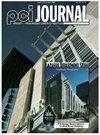Tensile behavior and design of adhesive anchors embedded in thin concrete members
IF 0.9
4区 工程技术
Q4 CONSTRUCTION & BUILDING TECHNOLOGY
引用次数: 4
Abstract
■ Test results were used to create a design model for adhesive anchors postinstalled in thin concrete members. The model's accuracy and variability are similar to code-based models for other applications. Precast concrete sandwich wall panel systems have been used in the construction industry for the past 50 years because of their structural and thermal insulation efficiency. Precast concrete sandwich panels consist of two thin concrete layers separated by a thermal insulation layer. The concrete layers are commonly made structurally composite using shear connectors. The thickness of the layers typically ranges from 2 to 5 in. (50.8 to 127 mm). Postinstalled anchors are used in these panels for purposes including beam supports, repairing alignments, and installation of canopies and signs. However, anchorage in precast concrete sandwich panels can be challenging because of the thinness of the concrete layers and the lack of research and code provisions regarding anchorage in such members. In addition, codes and specifications impose limits on the minimum concrete member thickness and minimum anchor embedment depth. These limitations further hamper the use of postinstalled anchors in sandwich panels.薄型混凝土构件中粘结锚的拉伸性能与设计
■试验结果用于创建粘接锚后安装在薄混凝土构件的设计模型。该模型的准确性和可变性与其他应用程序的基于代码的模型相似。预制混凝土夹芯墙板系统由于其结构和保温效率,在过去的50年里一直用于建筑行业。预制混凝土夹芯板由两个由保温层隔开的薄混凝土层组成。混凝土层通常采用剪切连接件进行结构组合。层的厚度通常在2到5英寸之间。(50.8至127毫米)。后安装锚用于这些面板的目的包括横梁支撑,修复对齐,以及安装檐篷和标志。然而,预制混凝土夹芯板的锚固可能具有挑战性,因为混凝土层很薄,而且缺乏关于此类构件锚固的研究和规范规定。此外,规范和规范对混凝土构件的最小厚度和最小锚杆嵌入深度进行了限制。这些限制进一步阻碍了后安装锚在夹层板中的应用。
本文章由计算机程序翻译,如有差异,请以英文原文为准。
求助全文
约1分钟内获得全文
求助全文

 求助内容:
求助内容: 应助结果提醒方式:
应助结果提醒方式:


